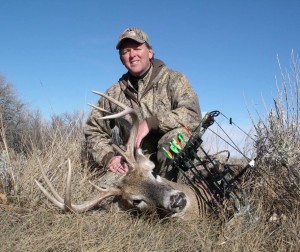 Right now, bucks are relatively docile and still locked into their summer bed-to-feed patterns. So long as you don’t press them too hard, they’ll keep moving reasonably well at dawn and dusk. Tweak these setups to your land. There’s a darn good chance you’ll tag out early.
Right now, bucks are relatively docile and still locked into their summer bed-to-feed patterns. So long as you don’t press them too hard, they’ll keep moving reasonably well at dawn and dusk. Tweak these setups to your land. There’s a darn good chance you’ll tag out early.
The Choke Point
One September I hunted in sprawling alfalfa and corn country where you could see deer coming and going for miles. The only way to have a fighting chance with a bow in a big spot like that is to narrow the country down, way down. During the middle of the day when the deer weren’t out, I looked around for two hours and sized things up. Then I tucked a tree stand back in a shady edge where a tractor path crossed a strip of weeds. There was a thin strip of timber upwind of my stand, and another strip 40 yards east of the farm road. I figured any deer that came off the alfalfa the next morning would gravitate to this choke point. If a shooter walked through there…
An hour after dawn, I glassed two racks a half-mile away. It took them a while to get to me. Around eight o’clock, the bucks hit the dirt road and walked down it. They turned, took the weed funnel between the tree strips and walked broadside 30 yards below. Darned if the plan didn’t work! I nailed the 8-pointer in the lead.
To me, bowhunting for whitetails is all about edges and choke points, or spots where old roads, strips of trees, pockets of weeds, ditches and other terrains and covers converge. Deer walk the funnels and edges year-round, and especially when locked into a bed-to-feed pattern in archery season. Set up where three or four strips and edges meet, and you’re apt to smoke a good buck like I did that morning.
Corner a Buck
Anytime I hunt a crop field or food plot I hit the nearest fence and walk it out to the corners. You can never scout too much, man, just be low-impact about it. Inevitably I find a corner with a lot of deer sign—tracks, a trail and maybe tufts of hair on the barbed-wire where deer are jumping it. A fence corner is a natural place for deer to travel, and a natural spot for you to set up. A prime corner to hunt will have lots of brushy cover, and at least one stout tree nearby for a stand. But if the sign is there and cover is sparse, I’ll play the wind and set up a small brush blind 35 yards or so off the corner. On the ground makes it tougher…and all the sweeter if you stick your buck in the corner.
The Waterhole
A hot, dry spell in late summer is a good time to pull off a field and lie in wait near a waterhole, where does and bucks often stop to stage and drink before moving out to feed on grain or clover at dusk. A pond, slough, spring or creek hole located near crops and/or mast is best. Try to scout out a water spot now, and go ahead and hang a tree stand. As you set up, keep a couple of things in mind. One, you might have a warm, southerly wind when bow season opens, so be ready for that. Two, try to post near a funnel that links the water and food. That might be a strip of timber, a ditch, etc. A lot of times, deer will walk on a weedy pond dam, so you might set up there if it’s an option.
On a hunting day, play the wind and sneak into your stand from the food source side by 2:00 p.m. You shouldn’t jump a single deer that is bedded back in the cover. If you don’t get a shot, wait until dark-thirty before climbing down. Sneak out of the woods downwind and out of sight of the nearest field where a bunch of deer are feeding. The fewer animals you bump on the way out, the better that stand will be tomorrow as your quest for an early-season bruiser continues.
Tree Stand-Hanging Pointers
- Look for a stout tree on the downwind side of a food source, trail or funnel. Back up 40 yards, kneel and check the tree from a deer’s perspective. If it offers adequate background cover, hang it there.
- For afternoon hunting in September or early October, lock a stand on a tree so that it faces a crop field or acorns. Most deer will come from the woods and thickets behind you; the tree between you and them will provide cover as you draw. Make sure the wind blows out of the cover and quarters out across the feed.
- With the leaves still thick on the trees in the early, you might be able to see and shoot best by setting up at only 16 feet or so high.
- Trim at least 3 good shooting lanes to the sides and front of your stand.





